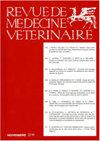Farmacocinética plasmática y urinaria de marbofloxacina intramuscular en caninos
Q2 Veterinary
引用次数: 0
Abstract
Plasma and urinary disposition of marbofloxacin was studied in canines (n = 6) after intramuscular administration of 2 mg/kg. At different times post-administration, blood samples were collected until 24 h, and urine samples, only from male dogs (n = 4) at 4; 8; 12, and 24 h. Liquid-liquid extraction of analyte with water, methanol, and centrifugation at 13500 rpm at 4 °C were performed. Separation and quantification were made using HPLC by reverse phase isocratic elution with a C18 column, fluorescence detector at 295 nm excitation and 490 nm emission, and a mobile phase consisting of water, acetonitrile, and triethylamine. Temporary plasma concentrations were analyzed with non-compartmental PK Solution 2.0 software. The results obtained indicate rapid absorption, as well as rapid and wide distribution. Cl and values of t½β and MRT indicate slow clearance and prolonged stay. The study evidenced plasma concentrations up to 24 h, which exceed the MIC of relevant pathogens. The AUC/MIC ratio indicates efficacy against microorganisms with MIC ≤ 0.15 μg/ml. Urinary levels of marbofloxacin are more significant than plasmatic levels. However, new studies are required to assess their use with the tested dose and route of application.研究了肌肉给药2 mg/kg后马布沙星在犬(n = 6)的血浆和尿液中的分布情况。在给药后的不同时间,采集血液样本,直到24 h,尿液样本,仅来自4只雄性狗(n = 4);8;12、24 h。用水、甲醇液液萃取分析物,在4℃下13500 rpm离心。色谱柱为C18,荧光检测器为295 nm激发、490 nm发射,流动相为水、乙腈、三乙胺,采用反相等容洗脱进行分离和定量。用无区隔PK Solution 2.0软件分析暂时性血浆浓度。结果表明,吸收快,分布快,分布广。Cl和t1 / 2 β和MRT值表明清除缓慢且停留时间延长。该研究证明了24小时的血浆浓度超过了相关病原体的MIC。AUC/MIC比值表明对MIC≤0.15 μg/ml的微生物有效。尿中马布沙星水平比血浆水平更显著。然而,需要进行新的研究,以评估它们在试验剂量和应用途径下的使用情况。
本文章由计算机程序翻译,如有差异,请以英文原文为准。
求助全文
约1分钟内获得全文
求助全文
来源期刊

Revue De Medecine Veterinaire
农林科学-兽医学
CiteScore
1.30
自引率
0.00%
发文量
0
审稿时长
18-36 weeks
期刊介绍:
The Revue de Médecine Vétérinaire publishes four kinds of text:
1) Scientific reviews on subjects related to veterinary and comparative medicine. Suggested length: 10 to 30 typed pages.
2) Original reports on fundamental or applied research. Suggested length: 10 to 15 typed pages.
3) Continuous education articles, that should be easily understandable by non-specialists. Suggested length: 10 to 15 typed pages.
4) Clinical reports. Suggested length: 5 to 15 typed pages.
The publication can be done in French language or English language.
For an article written in English by not english native speakers authors, the manuscript must be subjected by attesting that it was read again by an anglophone scientist or a scientific translator.
The authors must certify that the manuscript was not published or subjected for publication to another review.
The manuscript must be accompanied by a sheet signed by all the joint authors indicating their agreement for the tender of the manuscript.
The publication is free but a financial participation could be required for the photographs color. An estimate will be sent to collect the agreement of the authors.
 求助内容:
求助内容: 应助结果提醒方式:
应助结果提醒方式:


